Guatemala << `gwah` tuh MAH luh >> has more people than any other Central American country. Most of Guatemala’s people live in the rugged mountains in the central part of the country. There, on a high plateau, lies Guatemala City, the capital and industrial center of Guatemala, and the largest city in Central America.
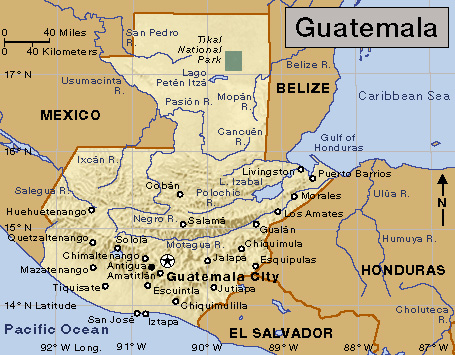
About 40 percent of the people are Indigenous (native) people whose way of life differs greatly from that of other Guatemalans. Their ancestors, the Maya, built a highly developed civilization hundreds of years before Christopher Columbus landed in America. Today, most Indigenous people live in peasant or farm communities apart from the main life of the country. Most speak Indigenous languages and wear Indigenous clothing. Most of the other Guatemalans—called Ladinos—have both Indigenous and Spanish ancestry. They speak Spanish and follow a Guatemalan form of Spanish-American customs. The Ladinos include peasants and laborers as well as the people in cities and towns who control the government and economy.
Guatemala’s main sources of income are exported farm products, especially coffee. Guatemala has close economic and political ties with the United States. The United States is Guatemala’s chief trading partner and imports much Guatemalan coffee. Most of Guatemala’s coffee is grown along the southern edge of the broad central mountainous region. A large, thinly populated plain with thick rain forests lies north of the mountains. South of the mountains, farmers grow such crops as corn, cotton, and sugar cane and raise beef cattle on a grassy lowland between the mountains and the Pacific Ocean.
Government
National government.
Guatemala has a democratic form of government. The people elect a president to head the government for a term of four years. A vice president elected by the people also serves a four-year term. The president and vice president are allowed to serve only one term. The president appoints a Cabinet of ministers who carry out the operations of the government. An elected Congress makes the laws of Guatemala. Members of Congress are elected by the people to four-year terms, which can be renewed.

Guatemala has several political parties. Major parties include the National Change Union, the National Unity of Hope, and VAMOS.
Local government.
Guatemala is divided into 22 departments for purposes of local government. The departments are divided into more than 340 municipios (cities or townships). A governor, appointed by the president, heads each department, except for the capital department. A mayor and a council, both elected by the people, head the capital department. An elected mayor and council also head each municipio.
Courts.
The highest courts in Guatemala are the Supreme Court of Justice and the Constitutional Court. There are also appellate (appeals) and local courts.
Armed forces.
Guatemala has an army, navy, and air force. Men between the ages of 18 and 50 may be drafted for military service.
People
The people of Guatemala may be divided into two main groups—Indigenous people and people with both Indigenous and Spanish ancestry. However, identity does not depend entirely on bloodline. It is chiefly a matter of how people live and of how they think of themselves. For example, a Guatemalan is considered Indigenous if he or she speaks an Indigenous language, wears Indigenous clothing, and lives in a community where the people follow Indigenous ways of life. The Indigenous people think of themselves more as part of their community than of their country. In isolated Indigenous communities, affairs outside the community attract little attention. Indigenous people make up about 40 percent of Guatemala’s population. Most of them are extremely poor and lack formal education.
About 60 percent of Guatemala’s people follow Spanish-American customs and traditions. These people are called Ladinos. They speak Spanish, the official language of Guatemala. Indigenous people, even ones without Spanish ancestry, may become Ladinos if they drop their Indigenous ways of life and join a Ladino community. Many Ladinos are poor farmworkers who are no better off than Indigenous people. Others control the government and the economy of the country. Ladinos are thought of chiefly in terms of their income and social class, not on the basis of how much Indigenous or Spanish ancestry they have.
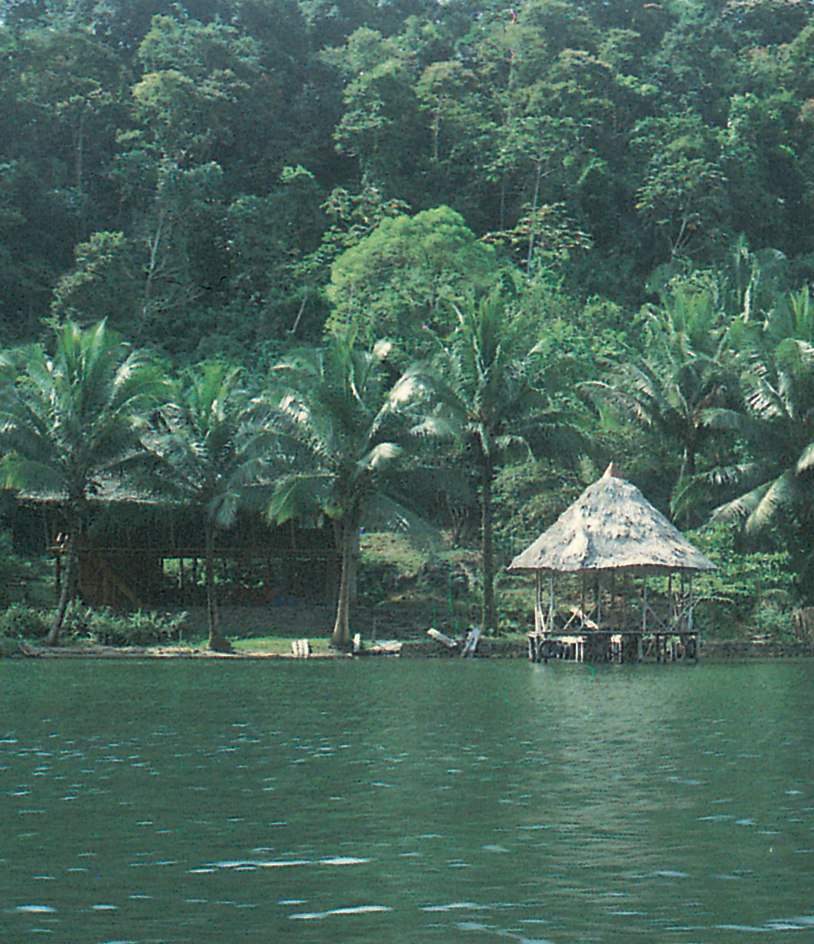
The Indigenous people live in small country settlements or in towns. Most of the Ladinos live in cities or towns. The number of Ladinos is increasing much faster than that of Indigenous people. This is largely because the Ladinos have greater opportunities for medical care in the cities and towns, which are chiefly Ladino. As a result, they have a lower death rate than the Indigenous people. There has also been a gradual shift among the Indigenous people toward Ladino ways of life.
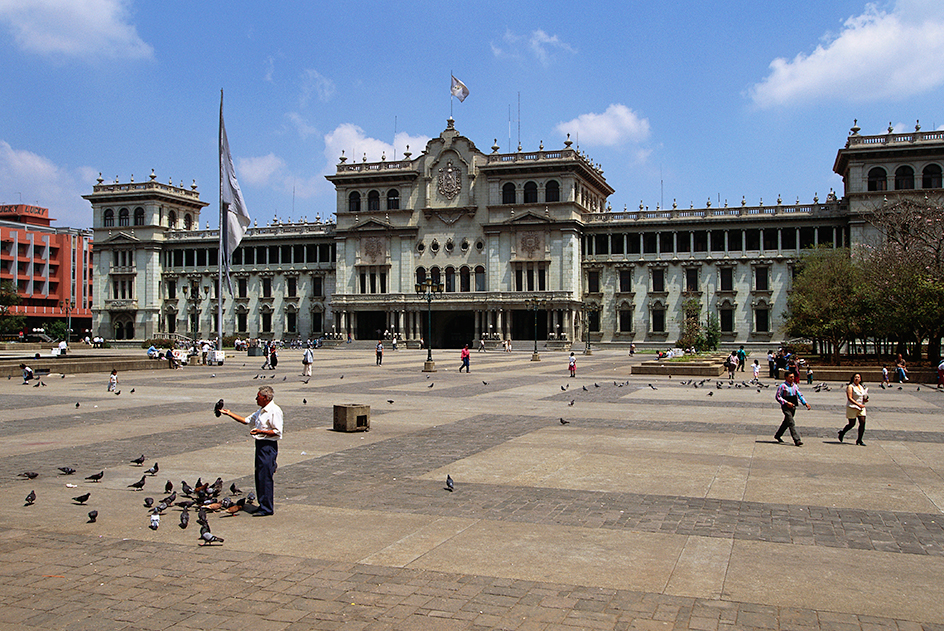
Indigenous people.
Almost all the Indigenous people in Guatemala speak one of the many Maya languages. Many of the men and some women also speak Spanish. There is hardly any social or political unity among Indigenous communities, even those of a single language group. An individual is known by his or her community. Social or political unity among Indigenous communities, even those of the same language group, is frequently strained. There are no organized tribes. The various tribes started to dissolve during the period of the Spanish conquest.
Almost every Indigenous community in Guatemala has its own colorful style of clothing. Indigenous people often travel far from home to trade in local markets or to find work. As a result, Indigenous people wearing a wide variety of clothing styles can be seen in many parts of central and western Guatemala.
The vast majority of all Guatemalans are Protestants or Roman Catholics. The Indigenous people also follow many religious practices from their pre-Christian past. They worship local gods and spirits along with God, Jesus Christ, the Virgin Mary, and their local patron saint. Such natural features as hills represent various Indigenous gods, and the people pray to them, especially during planting and harvesting times. 
Ladinos.
In farm areas with few Indigenous people, especially in the eastern and southern regions, Ladinos make up the laboring class as well as the middle and upper classes. Ladino peasants’ tools and homes are simple, much like those of the Indigenous people. The tools include an ax, digging stick, hoe, and machete. Some farmers with flat, fertile land have oxen and plows. Most farm Ladinos live in one- or two-room houses of adobe or pole walls, with roofs made of palm leaves, straw, or tiles.
In Indigenous areas, the Ladinos live in towns. They control much local commerce and politics. The few wealthy Ladinos have a high standard of living similar to that of wealthy people in other Western countries. The customs and clothing of Ladinos do not vary much by region, but by wealth and occupation.
Recreation.
In Guatemala’s Ladino cities and towns, the people enjoy such sports as basketball, bicycling, and soccer. For Ladino and Indigenous peasants, religious feast days provide the main sources of recreation. These holidays include religious processions, fireworks, and Guatemala’s famous marimba music. In Indigenous communities, the people also perform dances that represent events from history or legends.
Education.
Guatemalan law requires children to go to school from the age of 7 through 13. About 55 percent of the children attend primary school, but only about 15 percent go to high school. School attendance is much higher in the cities than in rural areas. Guatemala does not have enough schools for all its children, and some rural areas have no schools at all. Few of the country’s teachers speak the Indigenous languages. As a result, many rural Indigenous people cannot read and write. However, most of the urban Ladinos can read and write, and the country as a whole has more literate than illiterate people.
Guatemala has several universities. The University of San Carlos, in Guatemala City, is the oldest and largest. It was founded in 1676. Between 5 and 10 percent of the people of college age go to a university.
Population.
Approximately 6 percent of Guatemala’s people live in Guatemala City, the nation’s capital and largest city. More than 3 million people live in Guatemala City and its surrounding areas. Antigua was the capital of Guatemala during most of the Spanish colonial period.
The land
Guatemala has three main land regions: (1) the Northern Plain, (2) the Highlands, and (3) the Pacific Lowland.
The Northern Plain
is the most thinly populated and least developed part of Guatemala. Tropical rain forests of hardwood trees cover most of the plain, and there are some grasslands. Some chicle, a natural latex that was once widely used in making chewing gum, is taken from the trees. Many ancient Maya ruins, of which Tikal is perhaps the most famous, are in the forests. The country’s largest lake, 228-square-mile (591-square-kilometer) Lake Izabal, lies near the Caribbean Sea.

The Highlands
are a chain of mountains extending across Guatemala in an east-west direction. They are highest in the west. There, Volcán Tajumulco—the highest mountain in Central America—rises 13,845 feet (4,220 meters) above sea level. The region has many volcanoes, some of which are active. Earthquakes sometimes occur in the Highlands. Guatemala’s longest river, the 250-mile (402-kilometer) Motagua, rises in the Highlands and flows to the Caribbean Sea.
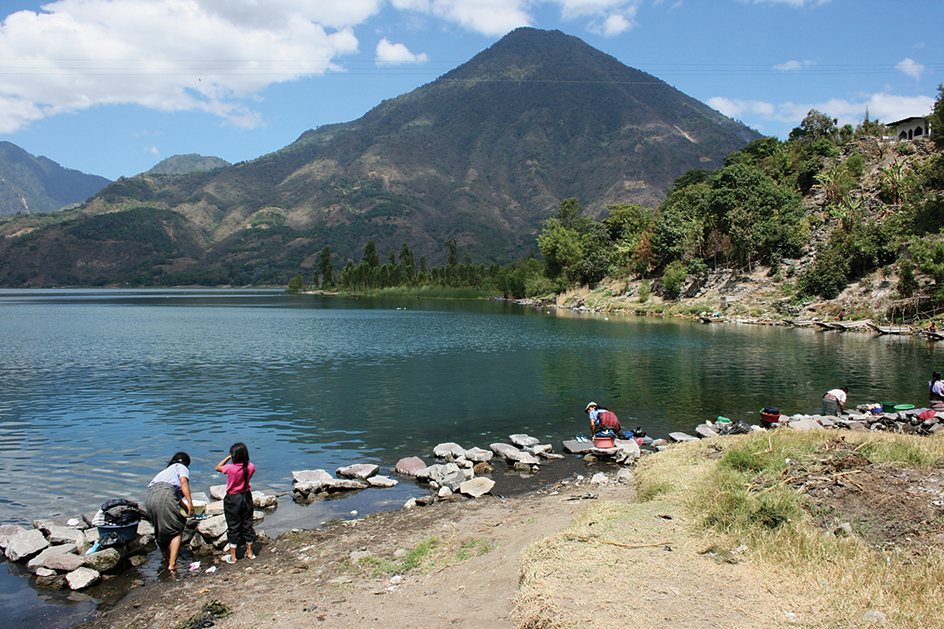
Most Guatemalans live in the Highlands, and most of the coffee- and corn-growing farmland is there. A majority of Indigenous people live in crowded communities in the western Highlands. Most people in the eastern Highlands are Ladinos. Guatemala City lies 4,850 feet (1,478 meters) above sea level in the middle of the region.
The Pacific Lowland
consists largely of farmlands. Many forest-lined streams that rise in the Highlands flow through the lowland to the Pacific Ocean. The lowland has been thinly populated, but its farmlands have been developed since the late 1940’s. The Pacific Lowland has sugar cane plantations, cattle ranches, and farms.
Climate
Guatemala has a tropical climate. Temperatures vary greatly from area to area because of differences in altitude. The plains and lowlands have an average yearly temperature of about 80 °F (27 °C), with little seasonal change. Mountain valleys 4,000 to 6,000 feet (1,200 to 1,800 meters) high are usually comfortably mild. They have a yearly average temperature of 60 to 70 °F (16 to 21 °C). The higher valleys sometimes have frost, and average 40 °F (4 °C).
The Pacific Lowland and western Highlands receive from 30 to 60 inches (76 to 150 centimeters) of rain a year, and the eastern Highlands get 20 to 30 inches (51 to 76 centimeters). The rainy season in Guatemala generally lasts from May to November, and daily showers fall during most of this period. Most of the Northern Plain receives from 80 to 150 inches (200 to 381 centimeters) of rain annually. There, rain falls throughout most of the year. The edge of a hurricane sometimes hits Guatemala, causing some damage to the country’s banana and coffee crops.
Economy
Guatemala is a developing country. Many Guatemalans, especially Indigenous ones, live in poverty. Remittances (money sent home) from Guatemalans living abroad and foreign aid are important to the economy.
Guatemala’s major natural resource is fertile soil, and farming is important to the country’s economy. Forest and mining resources also contribute. The country’s many mountain streams are a source of inexpensive hydroelectric power. Guatemala has several hydroelectric plants.
Agriculture
provides about a tenth of Guatemala’s gross domestic product (GDP)—the annual value of goods and services produced in the country. Agriculture employs about a third of the country’s labor force. The nation’s economy depends heavily on the export of farm products. 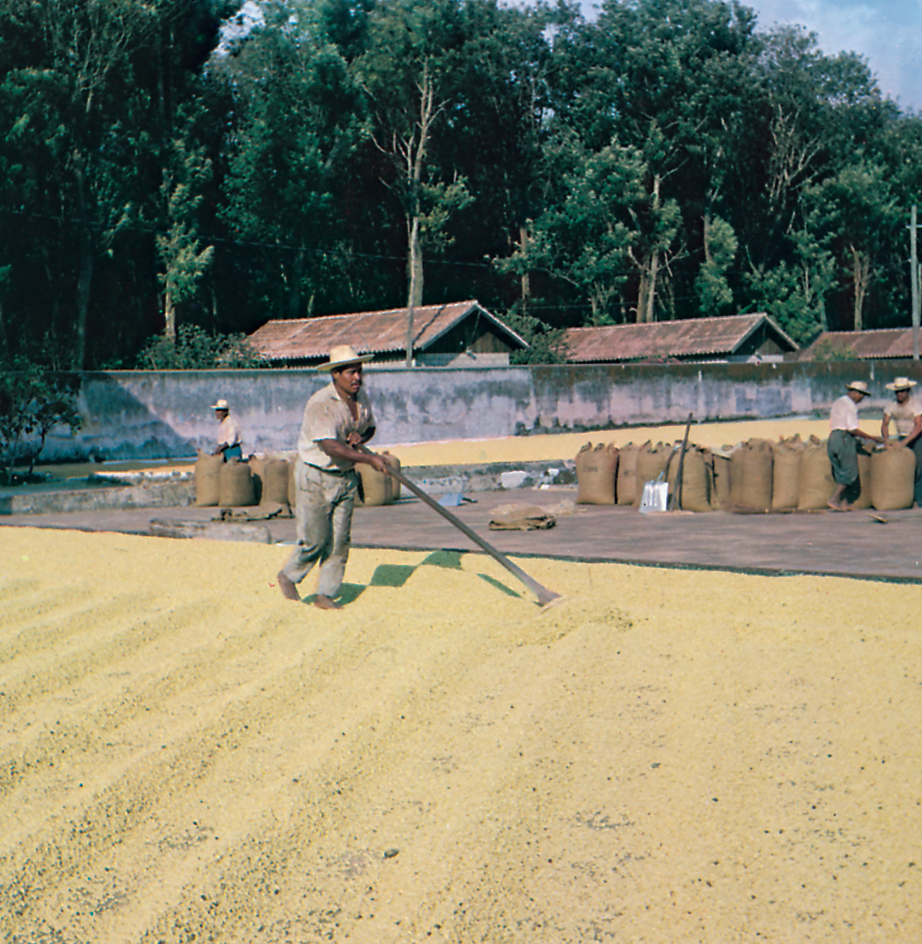
Bananas, coffee, and sugar cane are among Guatemala’s leading agricultural products. Bananas are grown mainly near Guatemala’s Caribbean coast. The best coffee-growing land extends along the southern edge of the Highlands region. Farmers in the Pacific Lowland region grow sugar cane. Cardamom, an important export, grows on the southern edge of the Highlands region. Other important crops include beans, corn, rubber, and tomatoes. Corn is the country’s main food crop. Farmers also raise beef and dairy cattle, chickens, and hogs.
Forestry and fishing play a small role in Guatemala’s economy. Thick forests cover about a third of the land. Most of the forests consist of cedrela, mahogany, and other hardwood trees. Guatemala’s fishing fleets catch shrimp, tuna, and other fishing catches. Aquaculture, the commercial raising of animals and plants that live in water, is a growing industry in Guatemala. Shrimp and tilapia are the most valuable products.
Service industries
are those economic activities that provide services rather than produce goods. Such activities employ about half of Guatemala’s labor force and account for over half of the country’s GDP. Trade, restaurants, and hotels form the most important category of services in Guatemala in terms of the GDP. Much of the country’s trade is based on the distribution of agricultural products. Restaurants and hotels greatly benefit from the many tourists who visit Guatemala each year. These tourists come from El Salvador, Honduras, the United States, and other countries. Services are most important in the large cities, especially Guatemala City.
Manufacturing and mining
account for about 20 percent of Guatemala’s GDP. Most of Guatemala’s manufactured products are consumer goods, such as processed foods and beverages, clothing, and textiles. Cement and chemicals are also valuable products. Much small manufacturing activity centers around Indigenous handicrafts, including blankets, pottery, and wood products.
Mining plays a small role in Guatemala’s economy. The country has deposits of gold, lead, silver, and zinc. Guatemala has oil reserves in the northern part of the country.
International trade.
Guatemala imports more than it exports. Leading imports include chemicals, machinery, motor vehicles, petroleum products, and pharmaceuticals (medicinal drugs). The country exports bananas, cardamom, clothing, coffee, and sugar. The United States is Guatemala’s leading trade partner. Guatemala also trades with China, Costa Rica, El Salvador, Honduras, Mexico, and Panama.
Transportation and communication.
Less than half of Guatemala’s roads are paved. Two major highways cross Guatemala from Mexico to El Salvador, and another connects the Pacific and Caribbean coasts. Few Guatemalans own an automobile. Many people travel by bus. Railroads link Guatemala City with both coasts. Guatemala City has an international airport. Major ports include Puerto Barrios and Santo Tomas de Castilla, both on the Caribbean Sea, and Puerto Quetzal, on the Pacific Ocean.
Most of Guatemala’s newspapers, radio stations, and television stations are privately owned. La Hora, Nuestro Diario, and Prensa Libre are among the country’s most popular daily newspapers. The country’s constitution guarantees freedom of the press. However, reporters face intimidation from drug traffickers and others.
History
Indigenous period.
Historians know little about the people who lived in what is now Guatemala before farming developed there. The earliest well-known society, at Las Charcas in the Highlands region, dates from the 1000’s B.C. The people of this community grew corn, made pottery, and wove mats and ropes.
Much of the famous Maya civilization thrived in Guatemala between A.D. 250 and 900. The Maya recorded important dates on tall, carved blocks of stone called stelae, and used a kind of picture writing. They built many large cities, mainly in the Northern Plain region. These cities included beautiful palaces, pyramids, and temples—all made of limestone. The Maya apparently abandoned these cities during the 900’s, for reasons that are not clear. When the Spaniards arrived, most of the Maya were living in the Highlands region.
Colonial period.
In 1523, a Spanish expedition led by Pedro de Alvarado set out from New Spain, the Spanish colony in Mexico, and invaded Guatemala. Alvarado defeated all the major Guatemalan Indigenous groups, and established Spanish rule in the country.
In 1570, Spain set up the Audiencia of Guatemala, a high court of judges and administrators, in what is now Antigua. The Spaniards found little gold or silver in Guatemala but stayed on as plantation owners with Indigenous labor. In 1776, the Audiencia was moved to Guatemala City after an earthquake destroyed Antigua.
Independence.
On Sept. 15, 1821, Guatemala and other Central American states declared their independence. They later became part of the Mexican empire, but they broke away in 1823 and formed the United Provinces of Central America. This union generally followed liberal economic and political policies. For example, the member states established various civil rights and ended the special privileges of powerful landowners.
The union began to fall apart under various pressures, including efforts by the conservative nobles to get their old privileges back. In 1839, Guatemala left the union. A conservative general, Rafael Carrera, then ruled as dictator-president for most of the period until 1865.
The liberals returned to power in 1871. They ended the special privileges that Carrera had restored, but the people still did not have political freedom. A number of liberal dictator-presidents ruled until 1944. They promoted economic development, especially coffee growing. Foreigners were encouraged to immigrate to Guatemala to develop the land. Germans became especially active in coffee production. In 1906, the United Fruit Company, a U.S. firm, began developing banana plantations in Guatemala.
The mid-1900’s.
In 1944, a 10-year period of social and economic revolution began after protests forced dictator Jorge Ubico to resign. A new constitution, adopted in 1945, provided political liberties that Guatemalans had never known. Under President Juan José Arévalo, the government promoted education and health measures and encouraged the growth of labor unions. Various political parties and a free press developed.
Colonel Jacobo Arbenz Guzmán became president in 1951. The next year, the government began to take over much privately owned land and distribute it among landless peasants. This program included large areas owned by the United Fruit Company, by then the largest landowner in Guatemala.
The United States government, which had begun to fear Communist influences in the Arbenz administration, supported a revolt against him. In June 1954, the rebels attacked from their base in Honduras. The Guatemalan Army refused to support Arbenz, and he resigned. A temporary military government was set up.
Guatemala’s fifth constitution was adopted in 1956, but political confusion continued. The army seized the government again in 1963, and a sixth constitution went into effect in 1966. Elections were held that year, and civilian government was restored under President Julio César Méndez Montenegro. But the country remained troubled. Secret political extremist groups from the right and left made terror raids. Guatemalan political leaders, the U.S. ambassador, and others were killed.
In 1976, a major earthquake struck Guatemala. It caused about 23,000 deaths and about $700 million worth of property damage.
Civil conflict.
In the late 1970’s, violence became widespread in Guatemala. Various groups of leftists fought government forces. The antigovernment groups included Indigenous and other rural people who had little economic and political power. Warfare between rebels and government forces caused many Indigenous people in the west and north to flee deeper into the mountains, to Mexico, or to the United States. More than 200,000 people died or disappeared during the conflict. Guatemalan military and security forces were blamed for a vast majority of the deaths and disappearances. In 1996, the opposition groups and the government signed a peace agreement ending the conflict. After the agreement was signed, about 40,000 refugees returned to Guatemala.
The late 1900’s and early 2000’s.
Guatemala held four presidential elections between 1970 and 1982. Military officers won each time. But many people claimed the elections were fraudulent. General Angel Anibal Guevara won the 1982 presidential election. But before Guevara took office, a group of military leaders took control of the government and established a three-member military junta (small ruling group). General Efraín Rios Montt, the junta’s leader, suspended the Constitution, abolished the Congress, and banned political party activities. Rios Montt removed the other junta members from power and declared himself Guatemala’s only leader. In 1983, military leaders overthrew Rios Montt.
In 1985, the people elected Marco Vinicio Cerezo Arévalo, a civilian, president of Guatemala. A new Constitution was written, the Congress was reestablished, and political party activities were allowed once again. The new civilian government took office in 1986. Guatemala’s military leaders tried several times to overthrow the civilian government, but their attempts were unsuccessful.
A new civilian president, Jorge Serrano Elias, was elected in 1991. In 1993, Serrano dissolved Congress and announced he would rule by presidential order. Many Guatemalans protested his actions. Guatemala’s military soon removed Serrano from office. Congress then elected Ramiro de León Carpio president.
Since the mid-1990’s, Guatemala’s people have elected the country’s presidents. They elected Álvaro Arzú Irigoyen in 1996, Alfonso Portillo Cabrera in 1999, Oscar Berger in 2003, Álvaro Colom in 2007, Otto Pérez Molina in 2011, Jimmy Morales in 2015, and Alejandro Giammattei in 2019.
In 2018, the Volcán de Fuego (Volcano of Fire) erupted in southern Guatemala, killing hundreds of people.
Bernardo Arévalo, a child of former president Juan José Arévalo, was elected president of Guatemala in 2023. During his campaign, he pledged to fight the political corruption that had characterized some earlier governments. Arévalo took office in early 2024, despite repeated efforts by his political opponents to prevent him from doing so.
